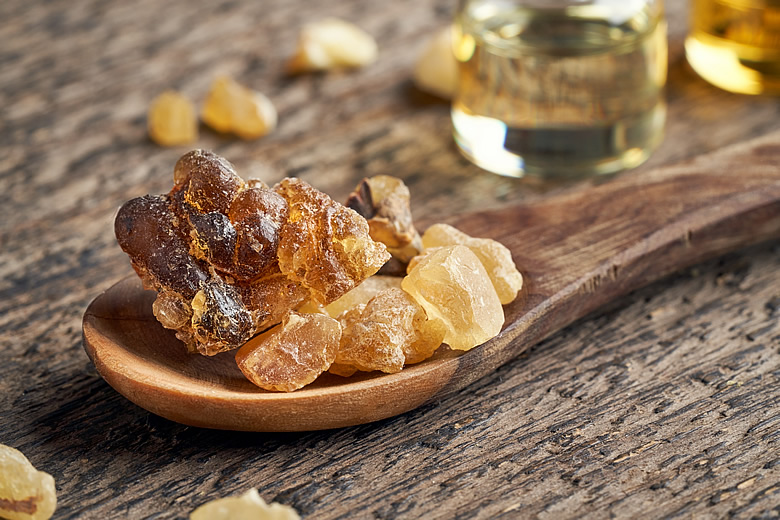Boswellia

Boswellia Serrata, also known as Frankincense, has been used in traditional Ayurvedic medicine for centuries. Boswellia has been found to be quite helpful in treating inflammation and pain,10-15 and it does this without causing ulcers like aspirin family medications.16 It has been shown in studies to be helpful for both rheumatoid arthritis17 and osteoarthritis.18
In the latter study, 30 patients with osteoarthritis of the knee were given 1,000 mg of either an extract of boswellia or a placebo for 8 weeks; the groups were then switched for the next 8 weeks. All of the patients on the boswellia showed significantly decreased pain and improved ability to walk. In fact, the improvement was quite remarkable, with the pain index falling by 90 percent after 8 weeks and a similarly dramatic increase in function. Boswellia has also been demonstrated to have significant anti-inflammatory properties. Boswellia inhibits leukotriene synthesis by inhibiting 5-lipooxygenase activity. It also decreases the activity of human leukocyte elastase (HLE). Unique to Boswellia is that it blocks two inflammatory chemicals that are increased simultaneously in a variety of human diseases.19 This results in its being helpful in asthma and colitis, as well as pain. In one study of asthmatics, 40 patients were treated with 300 mg 3 times day for 6 weeks. Seventy percent of the asthma patients showed improvement in symptoms and lung function and a decrease in allergic blood cells (eosinophils).20 Boswellia also helped in the treatment of ulcerative colitis. In one study of 20 patients in which Boswellia, 300 mg 3 times a day, was given for 6 weeks, 14 went into remission, while with sulfasalazine (the standard prescription treatment), the remission rate was 4 out of 10.21 Test tube studies suggest that Boswellia also markedly inhibits cancer.22-23
Boswellia does not appear to have any major side effects that resulted in people withdrawing from the studies and it rarely causes minor gastrointestinal disturbances or rash. A common dose is 350 mg 3 times a day.
References
10Singh, G.B., Atal, C.K. Agents and Actions 1986; 18: 407.
11Sharma, M.L., et al. Agents and Actions 1988; 24: 161.
12Sharma, M.L., et al. International Journal Immunopharm, 1989; 11: 647.
13Kar, A., Menon, M.K. Life Sciences 1969; 8: 1023.
14Menon, M.K., Kar, A. Planta Medica 1971; 19: 333.
15Sander, O., Herborn, G., Rau, R. [Is H15 (Resin extract of Boswellia serrata, “incense”) a useful supplement to established drug therapy of chronic polyarthritis? Results of a double-blind pilot study] Z Rheumatol, 1998;57: 11 – 6. German.
16Sharma, M.L., et al. Agents and Actions 1988; 24: 161.
17Etzel, R. Phytomedicine 1996; 3(1): 91 – 94.
18Kimmatkar, N., Thawani, V., Hingorani, L., et al. Phytomedicine 2003; 10(1): 3 – 7.
19Safayhi, H., et al. “Inhibition by Boswellic acids of human leukocyte elastase.” Journal of Pharmacological Experimental Therory, 1997 Apr;281(1): 460 – 3.
20Gupta, I., et al. “Effects of a Boswellia resin in patients with bronchial asthma: results of a double-blind, placebo-controlled, six week clinical study.” European Journal of Medical Research, 1998; 3: 511 – 514.
21Gupta, I., et al. “Effects of gum resin of Boswellia serrata in patients with chronic colitis.” Planta Medica 2001 Jul;67(5): 391 – 5.
22Hostanska, K., et al. “Cytostatic and apoptosis-inducing activity of boswellic acids toward malignant cell lines in vitro.” Anticancer Res, 2002 Sep-Oct;22(5): 2853 – 62
23Huang, M.T., et al. “Anti-tumor and anti-carcinogenic activities of triterpenoid, beta-boswellic acid.” Biofactors, 2000;13(1-4): 225 – 30.
